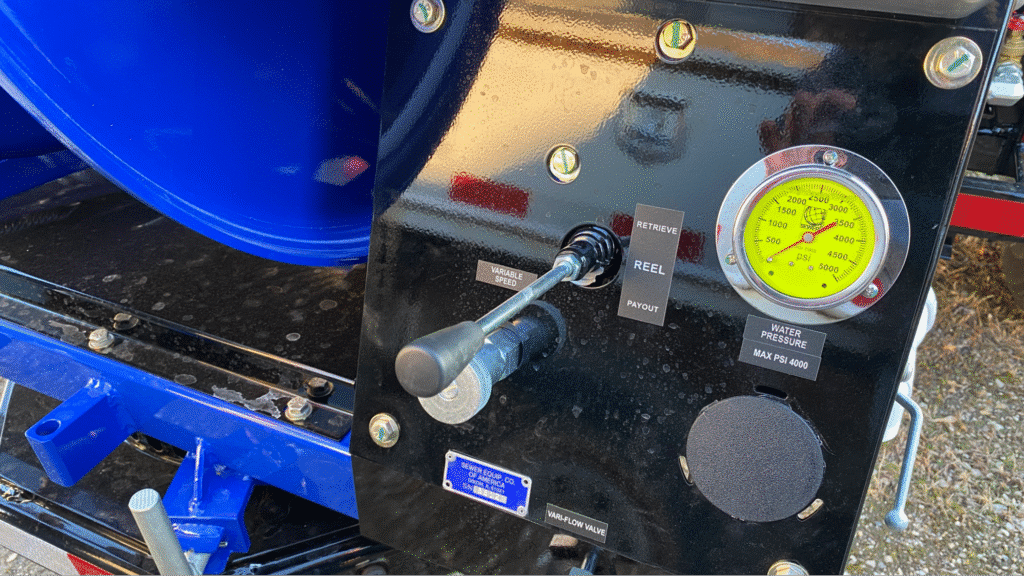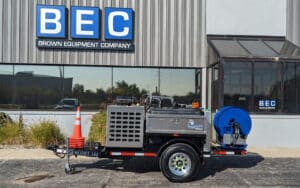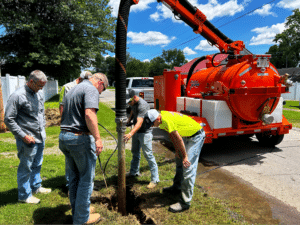Selecting the right jetter is crucial for ensuring efficient, safe, and cost-effective operations in sewer, water, and pipeline maintenance. Two key performance metrics—GPM (gallons per minute) and PSI (pounds per square inch)—determine a jetter’s ability to effectively clear debris and tackle tough blockages. This comprehensive guide unpacks these metrics, explains their roles in various applications, and provides practical advice to help you choose equipment tailored to your specific operational challenges.
The Basics of GPM and PSI
GPM measures the volume of water the jetter moves per minute, while PSI indicates the water pressure at which it is delivered. In simple terms, high GPM flushes large amounts of debris, and high PSI delivers the pressure needed to penetrate stubborn deposits. For example, when cleaning a clogged pipe, high GPM functions like a strong stream that washes away loose dirt, whereas high PSI acts like a powerful jet that breaks through hardened deposits. It is important to note that while high PSI helps address challenging blockages, it is not designed to replace mechanical force when slicing through extremely compacted soil or when structural cutting is required.
The Role of GPM and PSI in Different Applications
Different operational scenarios require unique combinations of GPM and PSI. The following examples illustrate how these metrics should be adjusted for various tasks:
Sewer Cleaning Applications
Municipal sewer cleaning typically involves removing varied debris such as sand, grease, and sediment. In these cases:
- High GPM is necessary for flushing out large volumes of loose material.
- Adequate PSI is needed to break down and dislodge hardened deposits without necessarily resorting to mechanical methods.
Maintaining the proper balance prevents damage to older sewer lines while ensuring that even stubborn waste is thoroughly removed.
Hydro Excavation Applications
Hydro excavation uses high-pressure water to safely remove soil around utilities and sensitive structures. Here:
- High PSI is critical for penetrating compacted soil layers to facilitate material removal.
- Sufficient GPM helps evacuate the loosened soil efficiently.
Hydro excavation is considered a precision task, where the controlled force of water both dislodges and carries away material without endangering nearby infrastructure.
Pipeline Cleaning Applications
Pipeline maintenance requires a tailored approach:
- High GPM is ideal for flushing larger pipes to clear accumulated debris.
- High PSI is beneficial for breaking down tough grime in older or smaller-diameter pipes.
Choosing the right specifications helps ensure thorough cleaning while protecting the pipeline material.
Seasonal Cleaning Challenges
Seasonal conditions, such as the build-up of leaves in fall or ice in winter, demand adjustments to GPM and PSI:
- In icy conditions or during heavy seasonal debris peaks, modifications in water flow and pressure help maintain optimal performance and safety.
This adaptive approach ensures that equipment remains effective throughout the year.
Key Factors to Consider When Choosing a Jetter
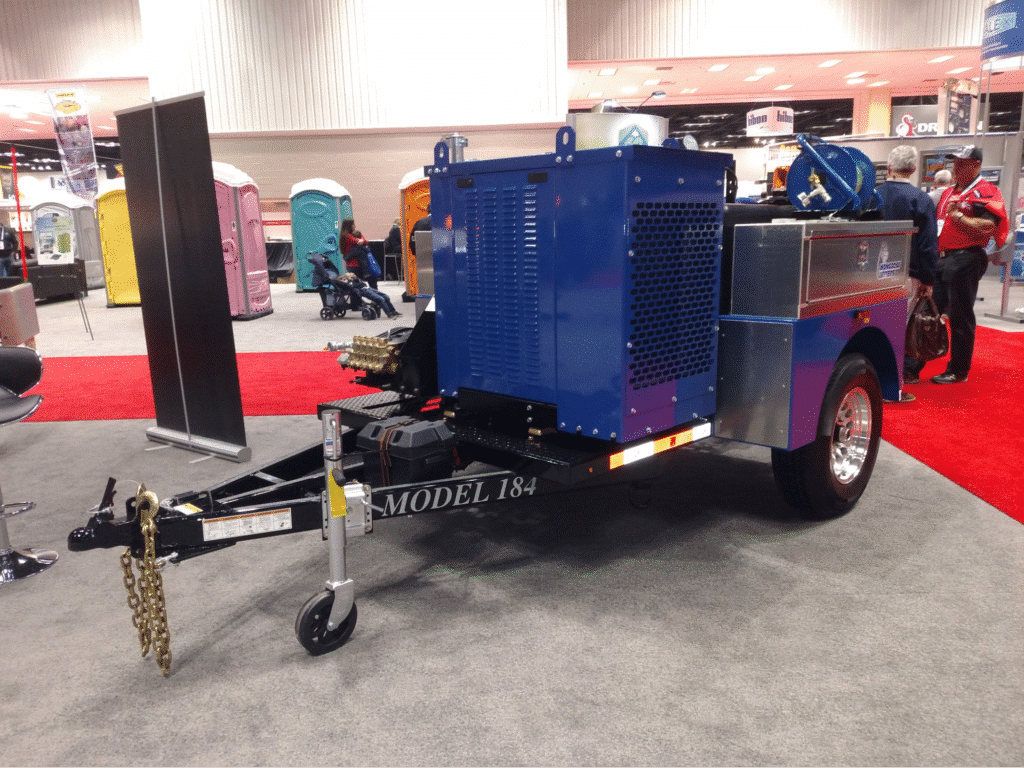
When selecting a sewer jetter, it is important to consider various factors to ensure the equipment is suited to your job-specific requirements. Equipping yourself with the right jetter is crucial for achieving efficient, safe, and cost-effective operation. Here are the key considerations to help you make an informed decision:
- Job Requirements:
- Identify the types of debris you typically encounter.
- Opt for high GPM to handle loose sediment efficiently.
- Prioritize higher PSI for removing tougher blockages effectively.
- Pipe Size and Material:
- Larger pipes benefit from increased GPM for thorough coverage and cleaning.
- Fragile or older pipes require lower PSI settings to minimize the risk of damage during cleaning.
- Distance and Accessibility:
- Long pipe runs and complex layouts can lead to pressure drops and performance issues.
- Choose equipment equipped with flexible hoses and adjustable nozzles to adapt to these challenges easily.
- Job Environment and Safety:
- Urban areas with delicate infrastructure require operations at lower PSI to avoid damaging sensitive surroundings.
- Industrial environments can usually accommodate higher PSI settings if the jetter includes robust safety features, such as emergency shut-off mechanisms, to ensure operator safety.
Selecting the right jetter involves more than just technical specifications; it’s about understanding your unique operational needs and tailoring your equipment choice accordingly. By weighing these key factors, you can ensure your jetter is efficient, safe, and ideally matched to your specific tasks, maximizing its effectiveness while minimizing potential risks.
Long-Term Advantages of Optimizing GPM and PSI
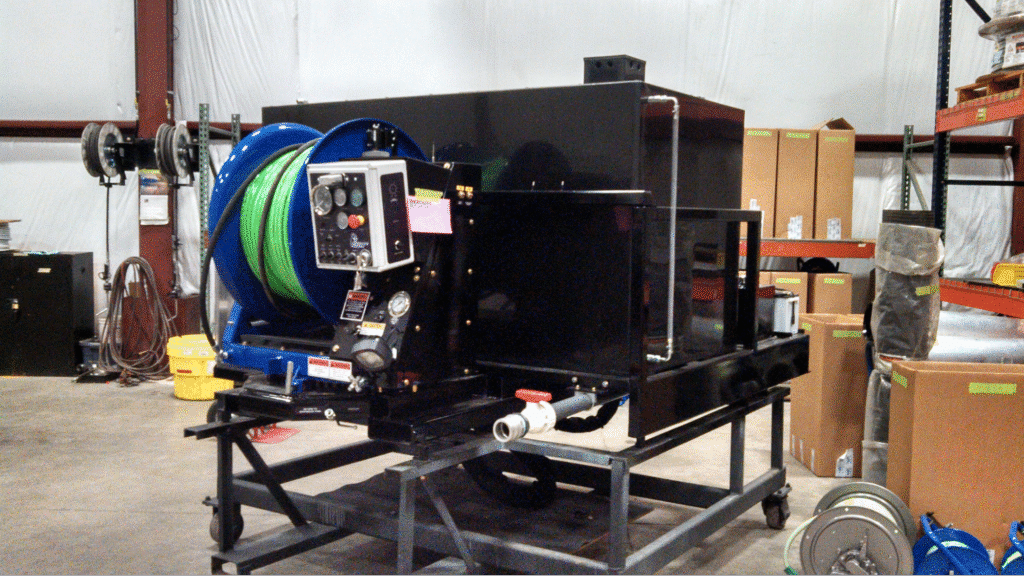
Balancing GPM (gallons per minute) and PSI (pounds per square inch) is crucial for enhancing the overall effectiveness of sewer jetters over the long term. This careful optimization not only ensures immediate operational success but also provides lasting benefits that extend well beyond the task at hand. By fine-tuning these two critical metrics, organizations can achieve significant gains in efficiency, cost effectiveness, and equipment lifespan. Below is a comprehensive list of the advantages you can expect from effectively optimizing GPM and PSI in your operations:
- Cost Savings:
- Reducing water and fuel consumption leads to lower operational expenses.
- Decreased wear and tear on equipment results in minimized maintenance costs.
- Improved Efficiency:
- Fine-tuning for specific performance needs ensures consistent and successful cleaning outcomes.
- Effective optimization results in reduced downtime through fewer breakages and service interruptions.
- Enhanced Equipment Longevity:
- Operating within an optimal range safeguards components, thereby extending the overall lifespan of the jetter.
- Regular, optimal use prevents premature aging and failure of the equipment’s parts.
- Minimized Environmental Impact:
- Efficient resource use helps minimize waste, making operations greener and more sustainable.
- Lower fuel and water usage reduce the carbon footprint and environmental pollutants.
- Increased Safety:
- Proper PSI settings help prevent damage to sensitive infrastructures, ensuring safer operations.
- Optimized equipment is less likely to encounter unexpected failures that could pose safety risks.
The advantages of optimizing GPM and PSI extend beyond mere operational checks; they create a sustainable and efficient foundation for long-term success. By implementing a balanced approach to these metrics, businesses not only enhance productivity and reduce operational costs but also improve safety and achieve greater equipment reliability. These benefits collectively contribute to smoother, more dependable workflows and bolster the overall resilience and effectiveness of sewer maintenance operations.
Steps for Evaluating and Testing Jetter Specifications
When considering the purchase of a sewer jetter, it’s crucial to ensure that the equipment not only meets your operational needs but also delivers reliable, long-term performance. Proper evaluation and testing can save you from costly errors. Here’s a detailed approach to interpreting and testing specifications to make a well-informed decision:
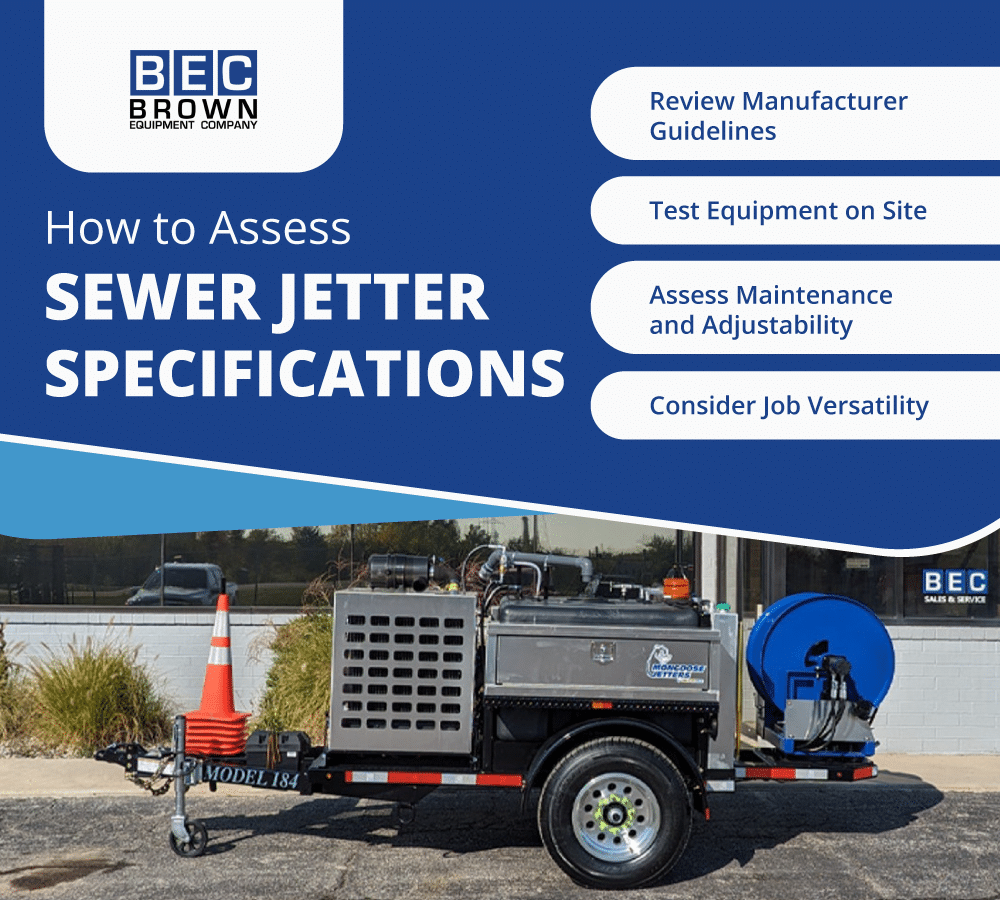
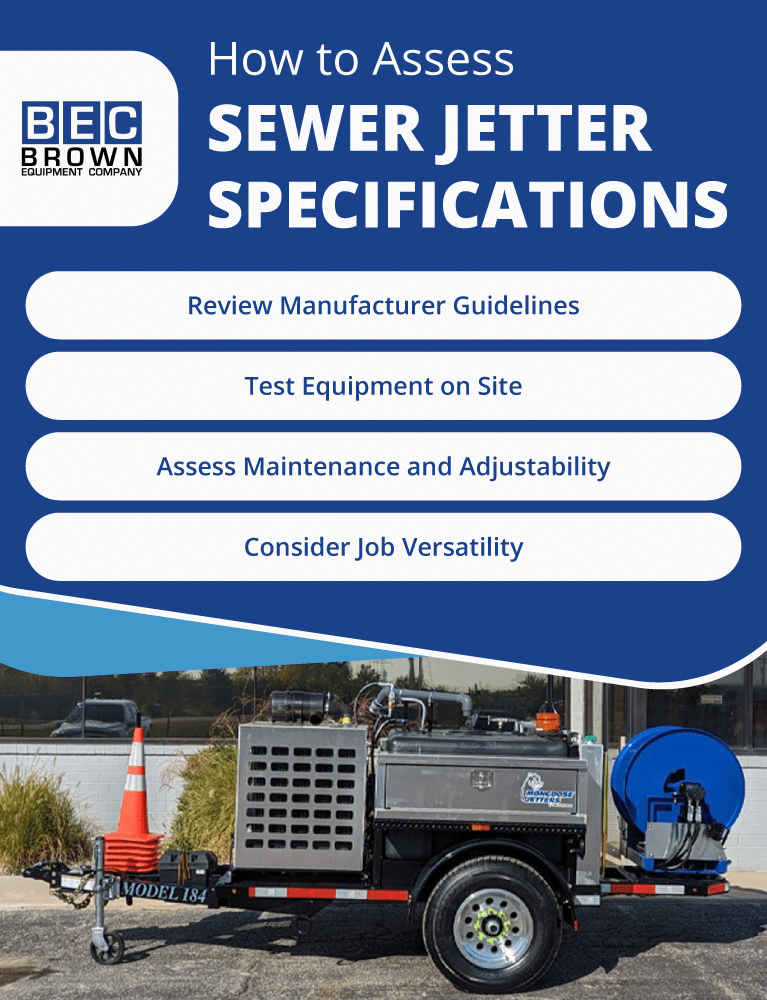
- Review Manufacturer Guidelines:
- Scrutinize the technical specifications provided by the manufacturer, paying close attention to the recommended GPM/PSI ranges.
- Make sure the recommended maintenance procedures align with operational realities to maximize machine lifespan.
- On-Site Testing:
- Request an on-site demonstration to assess how the jetter performs under real-world conditions.
- Observe for consistent water flow and pressure control to ensure dependable performance across various applications.
- Assess Maintenance and Adjustability:
- Confirm that the jetter features quick-connect fittings and easy access to components for simplified maintenance.
- Choose equipment that offers flexible GPM and PSI settings, allowing you to tailor operations to diverse tasks.
- Evaluate Job Versatility:
- Opt for a machine capable of both extensive flushing (high GPM) and powerful pressure (high PSI) to effectively handle different job requirements.
- This versatility can potentially minimize the necessity of investing in multiple pieces of equipment.
- Seek User Feedback:
- Look for testimonials or reviews from current users focusing on the jetter’s durability and effectiveness in similar operational conditions.
- Online forums or industry groups can provide additional insights into long-term satisfaction levels.
By following these comprehensive steps, you can confidently choose a sewer jetter that aligns with your specific needs and operational goals. Ensuring the jetter’s performance matches its specs prevents downtime and maximizes efficiency, ultimately leading to enhanced productivity and cost savings.
How Brown Equipment Company Supports Jetter Selection
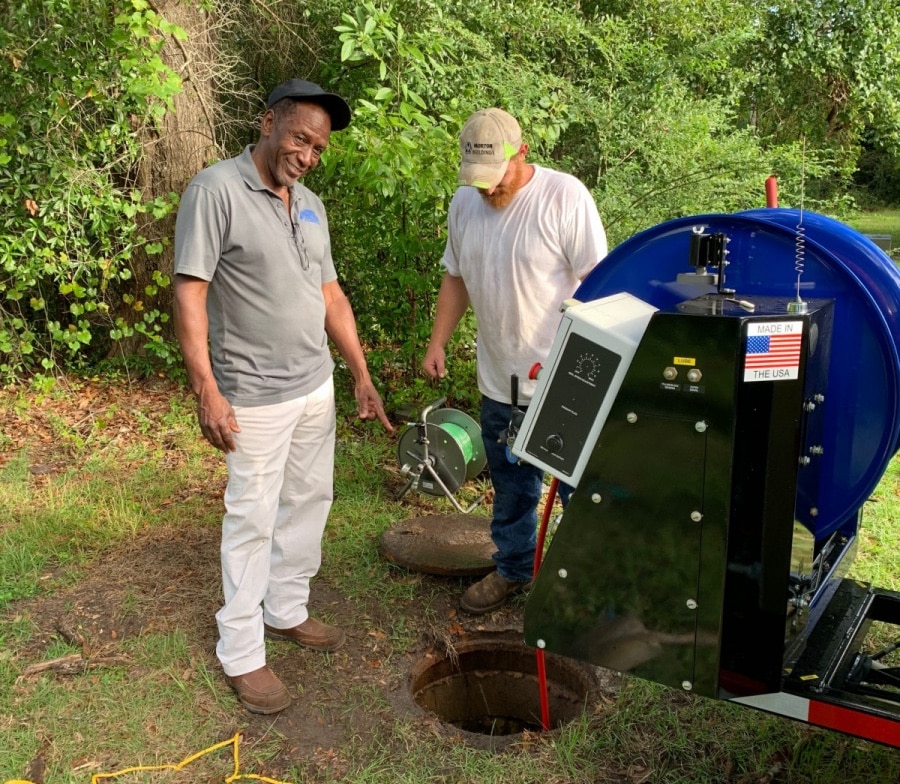
Partnering with the Brown Equipment Company team can enhance operational efficiency and safety, and support long-term cost management. Their experienced staff evaluates operational challenges and offers customized recommendations based on technical specifications and project requirements. On-site demonstrations, personalized training, and maintenance assistance help clients achieve optimal performance.
At Brown Equipment Company, we believe every win matters — big or small. It’s part of who we are and what drives us forward.
Check out the video below to see how we celebrate big and small, give grace, and always strive for excellence. Because when we live our BEC Blue values every day, every victory counts.
Regular Maintenance and Safety Best Practices
Taking a proactive approach to the regular maintenance and safety protocols of your sewer jetter is essential for maintaining operational excellence and ensuring the safety of your crew. Proper upkeep not only extends the lifespan of your equipment but also reduces the likelihood of costly downtime and repairs. By implementing systematic checks and following industry-standard safety precautions, you can safeguard your investment and keep your operations running smoothly.
Key Maintenance Practices:
- Routine Inspections:
- Conduct daily visual checks to identify any signs of wear or damage on hoses, nozzles, and pressure components.
- Look for leaks, cracks, or signs of fatigue that might indicate the need for immediate repair or replacement.
- Scheduled Maintenance:
- Adhere to a predetermined maintenance schedule that includes cleaning and replacing worn parts, coupled with thorough performance testing to ensure optimal function.
- Evaluate the pressure systems regularly to prevent malfunctions and ensure they operate within designated parameters, thereby maintaining efficacy.
Safety Protocols:
- Emergency Features Check:
- Regularly test emergency shut-off mechanisms and pressure regulators to ensure they are fully operational in case of unexpected situations.
- Verify that all safety devices are intact and capable of providing necessary protection to operators.
- Safety Training:
- Conduct regular training sessions to keep the crew updated on safety best practices and the correct use of the jetter’s features.
- Reinforce the importance of wearing protective gear and adhering to safety guidelines during all operational tasks.
By diligently following these maintenance and safety best practices, you can significantly reduce the potential for unexpected failures and extend the service life of your sewer jetter. This comprehensive approach not only maximizes the productivity and efficiency of your operations but also ensures the well-being of your workforce, fostering a safer and more reliable working environment.
Trends and Future Directions in Jetter Technology
As the industry evolves, innovations in jetter technology continue to emerge, and the demand for these powerful machines increases. Modern jetters are increasingly integrating smart sensors and real-time diagnostics that enable operators to monitor performance metrics closely. For instance, while advanced control systems are incorporating automation and sensor feedback for more informed decision-making, the capability for fully automated, blockage-specific adjustments to GPM and PSI levels is still developing. Presently, these systems support operators by providing real-time data, allowing them to manually fine-tune settings in response to observed pipe conditions and blockages.
Additional improvements include labor-saving features like remote monitoring and digital maintenance logs, which streamline operations and help minimize downtime. Manufacturers are also exploring eco-friendly designs aimed at reducing water consumption while maintaining effective cleaning. Enhanced operator training programs further support the safe adoption of these innovations.
Additional Considerations in Jetter Operations
Beyond technical specifications, it is essential to evaluate the environmental impacts and regulatory requirements associated with jetter operations. Operators should ensure that water runoff is managed appropriately, particularly in regions with strict environmental laws. Compliance with local conservation and waste management policies helps in deploying more sustainable practices. For example, understanding how water pressure breaks down stubborn buildup without over-reliance on chemical treatments is key when dealing with hardened deposits, while safely overcoming barriers like compacted soil remains critical.
Mastering GPM and PSI for Superior Jetter Performance
Balancing GPM and PSI is fundamental to effective jetter operations. By understanding the interplay of these metrics and customizing their application across various tasks—from sewer cleaning to hydro excavation—you can optimize performance while protecting your infrastructure. In an ever-shifting industry, staying informed about emerging technologies and best practices can ensure you continually maximize efficiency.
Optimized performance translates into reduced operating costs, increased efficiency, and longer equipment lifespans. With careful consideration of factors such as selecting the right equipment, maintaining robust maintenance schedules, and integrating advanced safety features to mitigate risks, your operations are set for success.
Ready to elevate your operations? Contact Brown Equipment Company today to schedule a free on-site demonstration of our sewer equipment, including a great selection of jetters, and discover how a careful balance of GPM and PSI can deliver effective and safe results for your projects.
